Related Research Articles
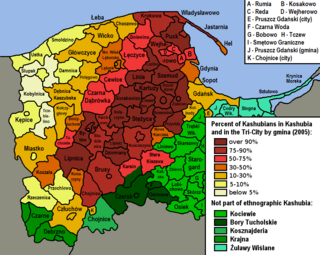
The Kashubians, also known as Cassubians or Kashubs, are a Lechitic ethnic group native to the historical region of Pomerania, including its eastern part called Pomerelia, in north-central Poland. Their settlement area is referred to as Kashubia. They speak the Kashubian language, which is classified as a separate language closely related to Polish.
Kashubian or Cassubian is a West Slavic language belonging to the Lechitic subgroup.

Bytów is a town in the Gdańsk Pomerania region of northern Poland with 16,730 inhabitants as of December 2021. It is the capital of Bytów County in the Pomeranian Voivodeship.

Brusy is a town in northern Poland, located in the Pomeranian Voivodeship. As of June 2023, the town has a population of 5,103.
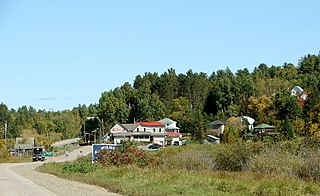
Wilno is a settlement in the Township Municipality of Madawaska Valley, Renfrew County, Ontario, Canada.
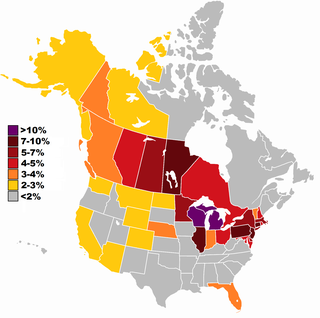
Polish Canadians are citizens of Canada with Polish ancestry, and Poles who immigrated to Canada from abroad. At the 2016 Census, there were 1,106,585 Canadians who claimed full or partial Polish heritage.
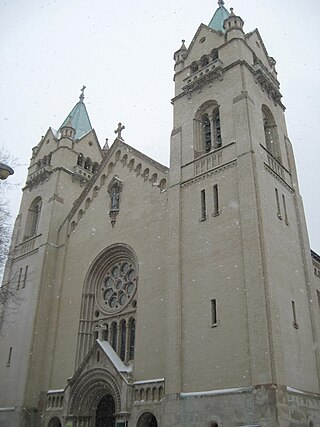
St. Josaphat is a historic church of the Roman Catholic Archdiocese of Chicago located at 2311 North Southport Avenue in Chicago, Illinois.

Sianowo is a village in the administrative district of Gmina Kartuzy, within Kartuzy County, Pomeranian Voivodeship, in northern Poland. It lies approximately 10 kilometres (6 mi) north-west of Kartuzy and 36 km (22 mi) west of the regional capital Gdańsk. It is located on the eastern shore of Sianowskie Lake, within the ethnocultural region of Kashubia in the historic region of Pomerania.
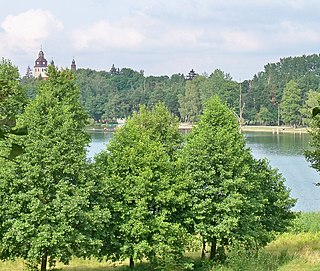
Wiele is a village in the administrative district of Gmina Karsin, within Kościerzyna County, Pomeranian Voivodeship, in northern Poland. It lies approximately 5 kilometres (3 mi) north-west of Karsin, 23 km (14 mi) south of Kościerzyna, and 71 km (44 mi) south-west of the regional capital Gdańsk. It is located in the Zabor Land, a southern part of the ethnocultural region of Kashubia in the historic region of Pomerania.
The Society of Young Kashubians was an association founded in 1912 in Gdańsk (Poland). Its leader was Dr. Aleksander Majkowski, already a well-known Kashubian writer and author of The Life and Adventures of Remus. Other influential members of the association were the attorney Jan Karnowski and two Roman Catholic priests, Leon Heyke and Józef Wrycza.

Pine Creek is an unincorporated community located in the town of Dodge, Trempealeau County, Wisconsin, United States. Pine Creek is located on Pine Creek and County Highway G 9.6 miles (15.4 km) west-northwest of Galesville.
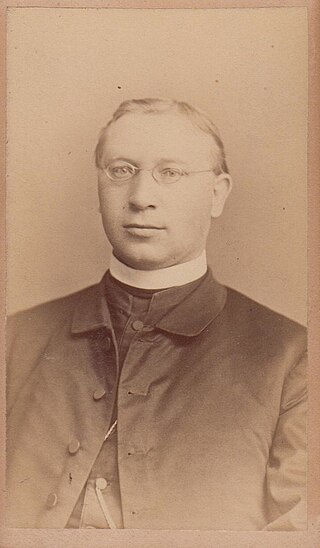
Jan Romuald Byzewski, better known in America as Father Romuald Byzewski, was born in the Kaszubian village of Karwia, in the Prussian jurisdiction of Danzig (Gdansk), on October 10, 1842.
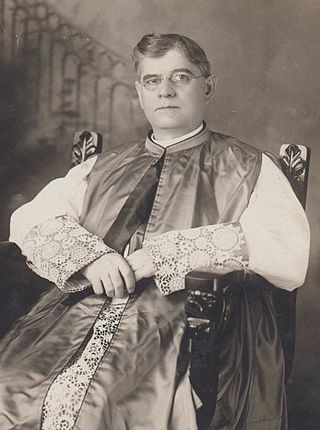
Jakub Wałenty Jan Pacholski, better known in America as Monsignor James W.J. Pacholski, was born on May 24, 1862, in the village of Pączewo, located in the Polish region of Kociewie.
Józef Franciszek Darzyn Ciemiński was a Polish-born Roman Catholic priest. He emigrated with his parents to the United States in 1881 and was ordained as a Priest in Saint Paul, Minnesota in 1895. He was involved with numerous Polish Catholic parishes during his lifetime including the now closed troubled Parish of Saints Peter and Paul in Duluth, Minnesota, and the parish of Holy Cross in Minneapolis.
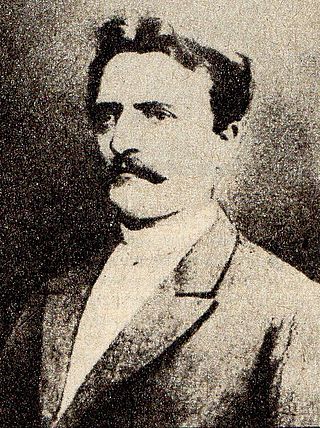
Hieronim Derdowski, Kashubian-Polish intellectual and activist, was born to Kashubian parents in the Pomeranian village of Wiele. By the time Derdowski emigrated to the United States in 1885, he had already studied for the Roman Catholic priesthood, been repeatedly incarcerated by the German authorities, and edited a newspaper in the city of Torun. At the time, however, Derdowski was better known as a poet. Within two years of reaching the United States he became editor of the Winona, Minnesota Polish-language newspaper Wiarus. In this role he gained a reputation as a strong voice for the Polish-American community, also known as Polonia.
Wiarus was the name of a Polish-language newspaper published in Winona, Minnesota from 1886 to 1893 and 1895 to 1919; in 1893 it was renamed Katolik, but reverted to its original name in 1895. Although Winona's Polish community was known at the time as the "Kashubian Capital of America," Wiarus was published in the "good" Polish spoken in Warsaw and Krakow. Wiarus also provided printing services for Winona's Kashubian Polish community. From 1886 to 1902, Wiarus was edited by the famed Kashubian-born poet and journalist Hieronim Derdowski. In its heyday, Wiarus was said to be the most widely circulated Polish-language newspaper in the United States.

Antoni Klawiter, the Roman Catholic and, afterward, independent Polish Catholic priest, was born in Chojnice, in modern Poland, on November 12, 1836. The scholarly consensus is that he was the son of Polonized Germans; by virtue of his Kashubian birthplace and his later experience pastoring Kashubians in Winona, Minnesota, he will not have been unfamiliar with the Kashubian culture. In 1859, he was ordained a Roman Catholic priest in Włocławek, and became four years afterward one of many Polish priests who were involved with the Polish Insurrection of 1863. In late 1873 or early 1874, Father Klawiter emigrated to the United States.
Kashubian Americans are Americans of Kashubian descent.
The history of Winona, Minnesota as a settlement begins with the foundation in 1851 in what was then Minnesota Territory on the West side of the Mississippi River. The site was of the village of Keoxa of Dakota people. The name "Winona" (Wee-no-nah) was noted to be the name of a first-born daughter in the local Dakota language.

Stefan Ramułt was a Polish scholar who specialized in the language and culture of the Kashubians.
References
- ↑ Hanna Popowska-Taborska, Kaszubszczyzna: zarys dziejów (Warszawa, 1980), p. 21.
- 1 2 "The Great Kashubian Migration".
- ↑ Ramult, Stefan (1899). Statystyka ludnosci kaszubskiej. Krakow: Polska Akademia Umiejętności. p. 243.
- ↑ Jozef Borszyskowski, The Kashubs, Pomerania and Gdańsk (English translation), p. 62.
- ↑ Jan L. Perkowski, "The Kashubs: Origins and Emigration to the U.S.," Polish American Studies, 23.1 (1966), p. 5.
- ↑ Cassubians
- ↑ Pacyga, Dominic (2004). Ember; Ember; Skoggard (eds.). Polish Diaspora. New York: Springer US. p. 257. ISBN 978-0-306-48321-9.
{{cite book}}:|work=ignored (help) - ↑ "Introduction to Soroka's Work".
- ↑ Blank, Joshua C. (2019). Creating Kashubia: History, Memory and Identity in Canada's First Polish Community. McGill-Queen's University Press. ISBN 9780773547209.
- ↑ "First Settlement in Winona: 1859". Bambenek.org. Retrieved 2017-07-21.
- ↑ "Kashubian Capital of America". Bambenek.org. Retrieved 2017-07-24.
- ↑ Sarah Biondich, "Squatting on Jones Island", ExpressMilwaukee.com, 24 June 2009]
- ↑ Derdowski, Hieronim (1899). "Appendix E: Ameryka". In Ramult, Stefan (ed.). Statystyka ludnosci kaszubskiej. Krakow: Polska Akademia Umiejętności. p. 240. OCLC 39546805.
- ↑ Blank, Joshua C. (2016). Creating Kashubia: History, Memory and Identity in Canada's First Polish Community. McGill-Queen's University Press. ISBN 9780773547209.